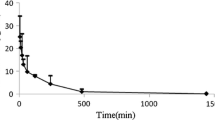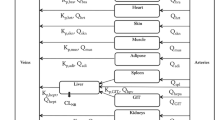Abstract
Determination of tissue levels is widely thought to provide useful information in the investigation of a new antibiotic, however this assumption is not fully justified. In this paper the following questions are covered. Firstly, the methodological problems encountered in the measurement of antibiotic levels in solid tissues and extravascular fluids are described. Secondly, the difficulties encountered in interpreting tissue concentrations are discussed, given the heterogeneity of distribution of drugs, potential intracellular penetration, binding to tissue proteins and local factors reducing antibacterial activity. Thirdly, the respective importance of animal and human data on tissue levels for prediction of efficacy is analysed. In some animal models it is possible to study the conditions affecting antibacterial activity and to obtain data relevant to the clinical situation. However, the inoculum effect, the metabolism of bacteria, the mechanism of the bactericidal action of drugs and the type of infected tissue are important factors to be taken into account. In humans, data obtained from infected tissue is sparse and contributes little to knowledge. Knowledge of tissue levels may be important for establishing whether data obtained in animals can be applied to humans or not. Fourthly, the importance of tissue levels in determining antibiotic dosages is evaluated. In humans, tissue levels are of limited value in the determination of unitary dose and dosage intervals in relation to the clinical response. Through serum levels of free drug, half-life at the β-phase and rate of in vitro killing are the most important parameters to be considered. Their relative importance depends mainly on the mode of action of the drug. Animal models may be useful for studying this question and the influence of the mode of administration of the drug on tissue levels.
Similar content being viewed by others
References
Kunin CM: Dosage schedules of antimicrobial agents: a historical review. Journal of Infectious Diseases 1981, 3: 4–11.
Eagle H, Fleischman R, Musselman AD: Effect of schedule of administration on the therapeutic efficacy of penicillin. American Journal of Medicine 1950, 9: 280–299.
Eagle H, Fleischman R, Levy M: Continuous versus discontinuous therapy with penicillin. New England Journal of Medicine 1953, 248: 481–488.
Weinstein L, Daikos GK, Perrin TS: Studies on the relationship of tissue fluid and blood levels of penicillin. Journal of Laboratory and Clinical Medicine 1951, 38: 712–718.
Mattie H, Kunst MW: The in vivo significance of tissue concentration. Infection 1976, 4, Supplement 2: 164–167.
Mattie H, Hoogeterp JJ, Hermans J: The relationship between plasma and tissue concentration of antibiotics. Description of a method. Journal of Pharmacokinetics and Biopharmaceutics 1987, 15: 191–202.
Schentag JJ, Swanson DJ, Smith IL: Dual indidualization: antibiotic dosage calculation from the integration of in vitro pharmacodynamics and in vivo pharmacokinetics. Journal of Antimicrobial Chemotherapy 1985, 15, Supplement A: 47–57.
Barza M: Principles of tissue penetration of antibiotics. Journal of Antimicrobial Chemotherapy 1981, 8, Supplement C: 7–18.
Bergeron MG, Trottier S, Lessard C, Beauchamp D, Gagnon PM: Disturbed intrarenal distribution of gentamicin in experimental pyelonephritis due toEscherichia coli. Journal of Infectious Diseases 1982, 146: 436–439.
Trottier S, Bergeron MG: Intrarenal concentrations of ampicillin in acute pyelonephritis. Antimicrobal Agents and Chemotherapy 1980, 19: 761–765.
Bergeron MG, Marois Y: Therapeutic benefit from high intrarenal levels of gentamicin when compared with ampicillin, cephalothin and trimetoprim in the treatment ofEscherichia coli pyelonephritis. Kidney International 1986, 30: 481–487.
Beauchamp D, Poirier A, Bergeron MG: Increased nephrotoxicity of gentamicin in pyelonephritic rats. Kidney International 1985, 28: 106–113.
Craig WA, Kunin CM: Significance of serum protein and tissue binding of antimicrobial agents. Annual Review of Medicine 1976, 27: 287–300.
Kornguth ML, Monson RA, Kunin CM: Binding of antibiotics to a soluble protein from rat liver. Journal of Infectious Diseases 1974, 129: 552–558.
Bryant RE, Hannond D: Interaction of purulent material with antibiotics used to treat pseudomonas infections. Antimicrobial Agents and Chemotherapy 1974, 6: 702–707.
Ahlstedt S: The antibacterial effects of low concentrations of antibiotics and host defence factors: a review. Journal of Antimicrobial Chemotherapy 1981, 8, Supplement C: 59–70.
Bundtzen RW, Gerber AU, Cohn DL, Craig WA: Post-antibiotic suppression of bacterial growth. Reviews of Infectious Diseases 1981, 3: 28–37.
Legett JE, Fantin B, Ebert S, Totsuka K, Vogelman B, Calame W, Mattie H, Craig WA: Comparative antibiotic dose-effect relations at several dosing intervals in murine pneumonitis and thigh-infection model. Journal of Infectious Diseases 1989, 159: 281–292.
Hessen MT, Pitsakis PG, Levison ME: Absence of post antibiotic effect in experimentalPseudomonas aeruginosa endocarditis treated with imipenem, with or without gentamicin. Journal of Infectious Diseases 1988, 158: 542–548.
Vogelman B, Gudmundsson S, Turnidge J, Leggett J, Craig WA: In vivo post-antibiotic effect in a thigh infection in neutropenic mice. Journal of Infectious Diseases 1988, 157: 287–298.
Wilkins TD, West SE: Therapy of anaerobic infection. Infection 1983, 11, Supplement 2: 105–109.
McCracken GH, Nelson JD, Grim L: Pharmacokinetics and bacteriological efficacy of cefoperazone, cefuroxime, ceftriaxone and moxalactam in experimentalStreptococcus pneumoniae andHaemophilus influenzae meningitis. Antimicrobial Agents and Chemotherapy 1983, 11: 233–238.
Decazes JM, Ernst JD, Sande MA: Correlation of in vitro killing curves and kinetics of bacterial killing in cerebrospinal fluid during ceftriaxone therapy in experimentalEscherichia coli meningitis. Antimicrobial Agents and Chemotherapy 1983, 24: 463–467.
Pangon B, Joly V, Vallois JM, Abel L, Buré A, Brion N, Contrepois A, Carbon C: Comparative efficacy of cefotiam, cefmenoxime and ceftriaxone in experimental endocarditis. Correlation with pharmacokinetics and in vitro efficacy. Antimicrobial Agents and Chemotherapy 1987, 31: 518–522.
Crémieux AC, Vallois JM, Mazière B, Ottaviani M, Bouvet A, Pocidalo JJ, Carbon C: A new approach of antibiotic diffusion into cardiac vegetations by autoradiography. Journal of Infectious Diseases 1989, 159: 938–944.
Bayers AS, Greenberg DP, Yih J: Correlates of therapeutic efficacy in experimental methicillin resistantStaphylococcus aureus endocarditis. Chemotherapy 1988, 34: 46–55.
Roosendaal R, Bakker-Woudenberg IA, Berghe Van Raffe M, Van Den Berg JCV, Michel MF: Compariative activities of ciprofloxacin and ceftazidime againstKlebsiella pneumoniae in vitro and in experimental pneumonia in leucopenic rats. Antimicrobial Agents and Chemotherapy 1987, 31: 1809–1815.
Muller T, Phillips S, North D: Pharmacokinetics of gentamicin in the treatment of renal infection: a therapeutic abnormality explained. Kidney International 1979, 15: 164–166.
Norden C, Shaffer TM: Treatment of experimental chronic osteomyelitis due toStaphylococcus aureus with vancomycin and rifampin. Journal of Infectious Diseases 1983, 147: 352–357.
Norden C, Niedveiter K, Shinners EM: Treatment of experimental chronic osteomyelitis due toStaphylococcus aureus with teicoplanin. Infection 1986, 14: 136–138.
Norden C: Experimental osteomyelitis. IV: Therapeutic trials with rifampin alone or in combination with gentamicin, sisomicin and cephalothin. Journal of Infectious Diseases 1975, 132: 493–499.
Joly V, Pangon B, Vallois JM, Abel L, Brion N, Buré A, Chau NP, Contrepois A, Carbon C: Predictability of antibiotic levels in cardiac vegetations and of in vivo effect of ceftriaxone in experimentalEscherichia coli endocarditis. Antimicrobial Agents and Chemotherapy 1987, 31: 1632–1639.
Carbon C, Chau NP, Contrepois A, Lamotte-Barillon S: Interstitial diffusion and accumulation of cephalothin according to various modes of intermittent administration to rabbits. Journal of Antimicrobial Chemotherapy 1978, 4: 349–353.
Kozak J, Gerding DN, Peterson LR, Hall WR: Gentamicin intravenous infusion rate: effect on interstitial fluid concentration. Antimicrobial Agents and Chemotherapy 1977, 12: 606–608.
Lavoie GY, Bergeron MG: Influence of four modes of administration on penetration of azthreonam, cefuroxime and ampicillin into interstitial fluid and fibrin clots and on in vivo efficacy againstHaemophilus influenzae. Antimicrobial Agents and Chemotherapy 1985, 28: 404–412.
Bergeron MG: Tissue penetration of antibiotics. Clinical Biochemistry 1986, 19: 90–100.
Maesen FPV, Beewkes H, Davies BI, Buitendijk HJ, Branbacher PJ: Bacampicillin in acute exacerbations of chronic bronchitis: a dose range study. Journal of Antimicrobial Chemotherapy 1976, 2: 279–285.
Wise R, Gillett AP, Cadge B, Durham SR, Baker S: The influence of protein binding upon tissue fluid levels of six β-lactam antibiotics. Journal of Infectious Diseases 1980, 142: 77–82.
O'Neill P, Nye K, Donce G, Andrews J, Wise R: Pharmacokinetics and inflammatory fluid penetration of cefpodoxime proxetil in volunteers. Antimicrobial Agents and Chemotherapy 1990, 34: 232–234.
Moore RD, Lietman PS, Smith CR: Clinical response to aminoglycoside therapy. Importance of the ratio of peak concentration to minimal inhibitory concentration. Journal of Infectious Diseases 1987, 155: 93–99.
Andersen ET, Young LS, Hewitt WL: Simultaneous antibiotic levels in break through gram-negative rod bacteremia. American Journal of Medicine 1976, 61: 493–497.
Drusano GL, Ryan PA, Standiford HC, Moody MR, Schimpff SC: Integration of selected pharmacologic and microbiologic properties of three new β-lactams: a hypothesis for rationale comparison. Reviews of Infectious Diseases 1984, 3: 357–363.
Author information
Authors and Affiliations
Rights and permissions
About this article
Cite this article
Carbon, C. Significance of tissue levels for prediction of antibiotic efficacy and determination of dosage. Eur. J. Clin. Microbiol. Infect. Dis. 9, 510–516 (1990). https://doi.org/10.1007/BF01964293
Issue Date:
DOI: https://doi.org/10.1007/BF01964293




